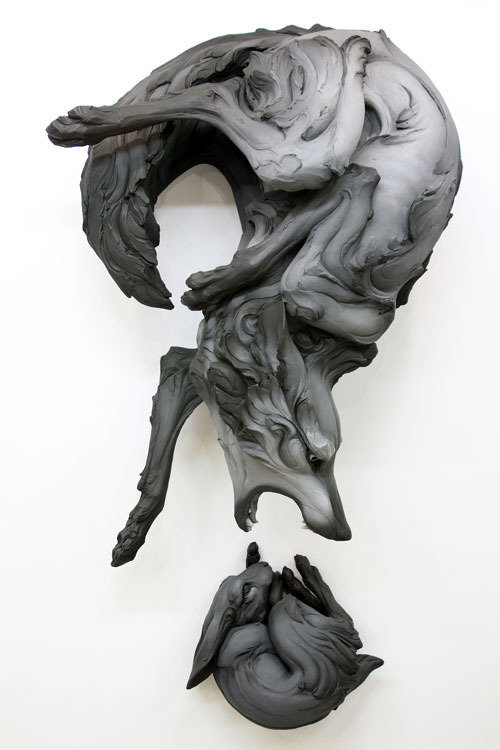Beth Cavener Stichter
dal 12/9/2012 al 19/10/2012
Segnalato da
12/9/2012
Beth Cavener Stichter
Claire Oliver Gallery, New York
Come Undone. The artist cajoles the viewer into looking at the darker side of the human condition by cloaking it in animal skin.

Too often, looking at artistic representations of the human form proves
unsatisfactory. Although the viewer may be able to identify and ap-
preciate the emotions in a portrait, the specificity of many human
portrayals, even if unintentional, jeopardizes the work’s pertinence. In
"Come Undone," the new body of work by sculptor Beth Cavener
Stichter, the Artist cleverly selects animal forms as human surrogates.
Using their nonthreatening images, devoid of specified associations,
she is able to convey relatable stories and emotions we might other-
wise dismiss out of hand.
In these seductive, large-scale works made from clay, Cavener Stich-
ter cajoles the viewer into looking at the darker side of the human
condition by cloaking it in animal skin. Her subjects elicit empathy,
expressing complex emotions and relationships while permitting us to
finally examine humanity closely enough to fully consider it -- and to
connect on a rare personal level.
A life-sized sculpture of a lamb makes for an unexpected chandelier,
lit from within and suspended from the ceiling. A sensuous hare dangles a tattooed leg suggestively
over the edge of its sculpture stand, all the while sustaining the piercing eye contact Cavener Stichter's
works are known to possess. Each work heightens our visual interest while dramatizing states of grace,
fear, desperation, and beauty.
It is the Artist's extraordinary interventions into the typical ceramic
process that make her work iconic. Each piece is testimony to a
truly innovative studio practice. While the properties of her chosen
medium enable her an eloquence of form and surface unavail-
able through other media, she pushes the process further through
a construction both delicate and time consuming. She begins with
a solid block of terra cotta, taking care to create her signature
"painterly" sweeping strokes in the clay. Cavener Stichter then cuts
the work into small, manageable sections, severing the limbs and
torso at the joints to re-work and re-articulate the musculature, skin,
and fur. The next step is to painstakingly hollow out each section
until it is very thin and thus fires to an extreme strength. After the
kiln, she re-assembles the pieces and paints the finished work.
Beth Cavener Stichter's studio process is chronicled in an article in
last month's Sculpture Magazine; her work is also featured on the
cover. Sculptures by the Artist are included in the public collections
of the Smithsonian Institution of American Art (Washington, D.C.),
the 21C Museum (Louisville, KY), and the Museum of Fine Arts
(Houston, TX), among others. She has lectured extensively on her
practice throughout the world. This is the Artist's second solo
exhibition at Claire Oliver Gallery.
Image: The Question That Devours, Stoneware, 162.6 x 89 x 63.5 cm.
Opening Reception with the Artist Thursday, September 13, 6-8 pm
Claire Oliver Gallery
513 West 26th Street, New York, NY 10001
Hours of Operation: Tuesday-Saturday 10:00 am - 6:00 pm



